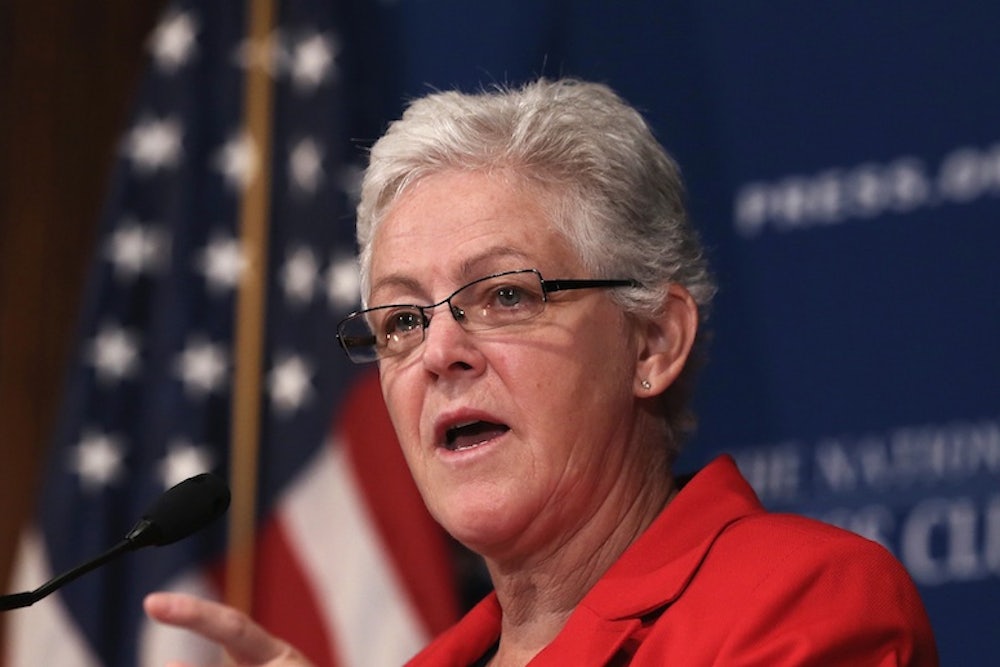Today marks the beginning of the biggest fight Obama faces to determine his climate change legacy. This morning, Environmental Protection Administrator Gina McCarthy, speaking at the National Press Club, proposed substantial limits on carbon dioxide for all new gas and coal-fired power plants.
The draft regulations, which would make it extremely hard to bring any new coal plants online, are not a huge environmental game-changer all by themselves. As Brad Plumer writes at Wonkblog, with natural gas prices as low as they are, utilities today aren’t planning many new coal plants. What makes these rules truly significant is that they will be the first to ever regulate the carbon-dioxide emissions of power plants, the largest cumulative source of emissions in the American economy. They thus set the stage for the more truly meaningful regulations Obama plans to introduce in his second term, on carbon-dioxide emissions from existing power plants. That makes them natural testing grounds for industry and environmental lobbyists—and for some of the same legal challenges that are expected to beset the draft rules to regulate existing power plants. The stakes are high for both sides. While the average natural gas plant today meets the proposed emissions limits for gas plants, of 1,000 pounds of carbon dioxide per megawatt-hour, the new rules limit new coal plants to emissions of 1,100 pounds of carbon dioxide per megawatt-hour. Existing coal plants average 1,768 pounds. Expect the phrase "war on coal" to get a lot of exercise in the coming months.
EPA regulations like these are the last, best option Obama has for making a big impact on the U.S.’s carbon output without the cooperation of Congress. And doing so is a dicey approach. These new draft rules, and the rules the EPA will release next year regarding existing power plants, rely on a 2007 Supreme Court ruling that compels the EPA to regulate carbon dioxide emissions if it finds they are harmful to humans. But as a big picture approach to carbon emissions, that’s a much shakier gambit than the cap-and-trade scheme that died in Congress in 2009 (and has, obviously, no chance of revival in this congress). As Coral Davenport reported at National Journal, the Clean Air Act, the law the Supreme Court interpreted as applying to carbon-dioxide emissions, was not designed to address climate change. The wording of these rules, then, is paramount to their ability to survive court challenges. The EPA has already delayed these rules once for fear that they were not likely to survive.
The rules announced today now undergo a 60-day period in which they are open for public comments, which the EPA will consider when making any changes to the draft rules. Plumer has put together a fine primer on how, precisely the rules work—by requiring new power plants to demonstrate to the EPA that they can meet certain emissions standards before they are permitted. Any coal-fired plant built in the future will have to rely heavily on carbon capture technology—a nascent technology that is at present very expensive—to meet these limits. Notably, Plumer writes, “Power plants that can capture and store their carbon are initially expected to cost about 75 percent more than regular coal plants.” Obama officials hope the rules will be finalized by late 2014. At that point, opponents of the rules can have at them in court. And by then, an even more dizzying brawl over regulations for existing power plants will be underway—rules which really do have the potential to turn the lights off at polluting coal plants. If Obama really is at war with coal, call this the opening shots.
Molly Redden is a New Republic staff writer. Follow her on Twitter @mtredden.
